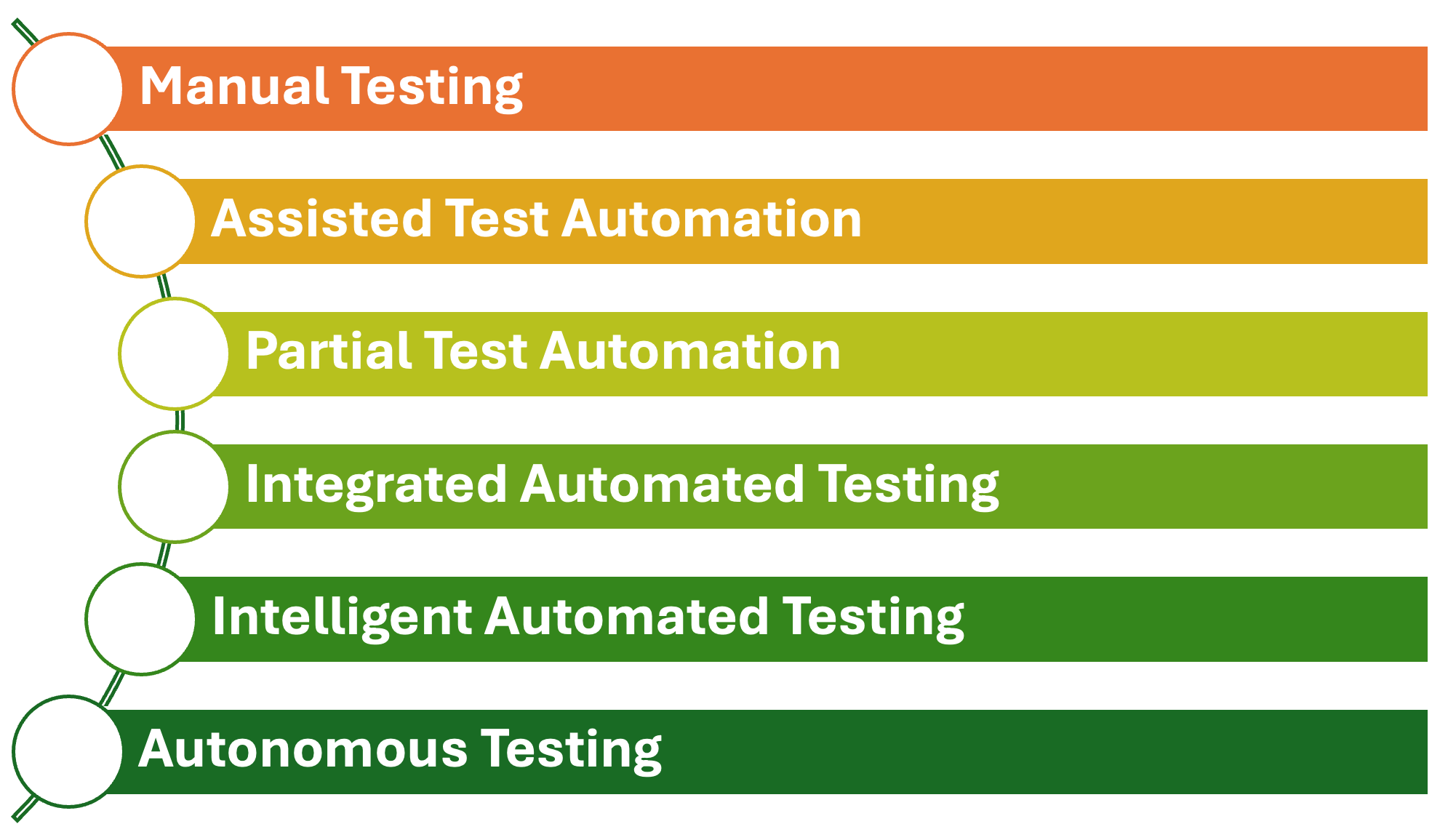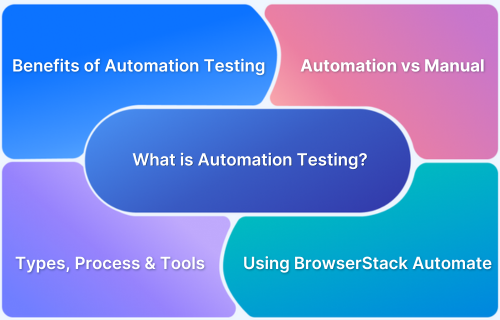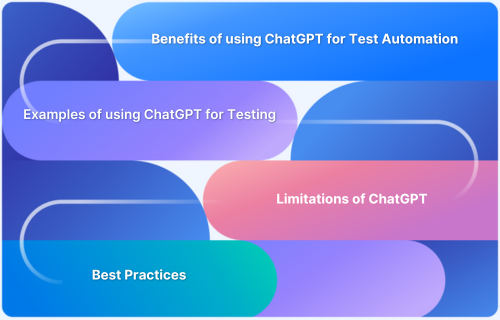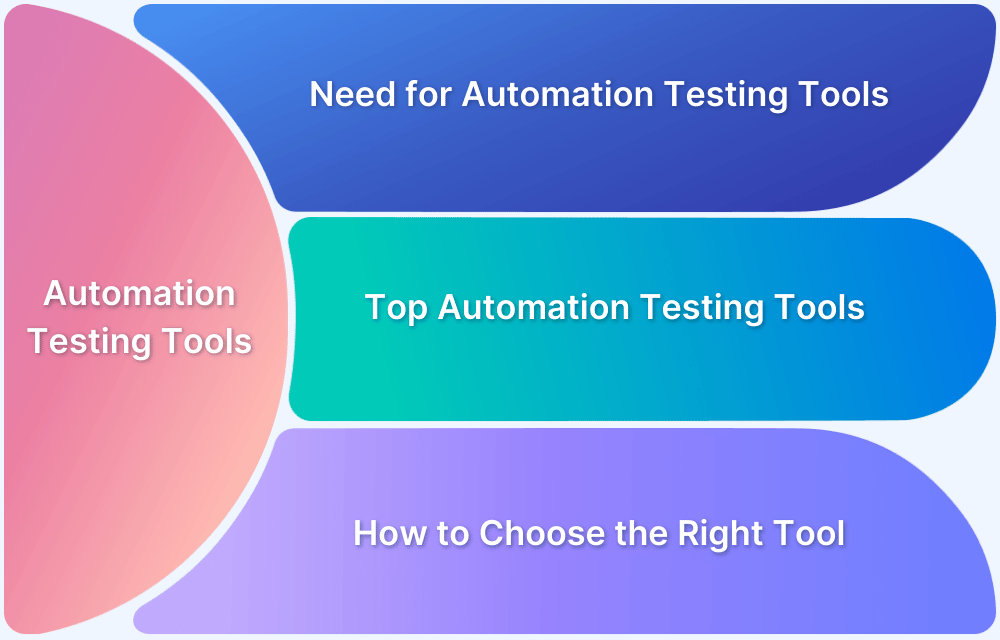Autonomous testing allows you to automate the entire software testing lifecycle using artificial intelligence (AI) and machine learning (ML). It enhances efficiency by self-learning from test execution, adapting to changes, and identifying issues faster than traditional automation.
Overview
What is Autonomous Testing?
Autonomous testing is an AI-driven approach that automates test creation, execution, and maintenance with minimal human effort. It uses machine learning to analyze application behavior and improve test accuracy over time.
Benefits of Autonomous Testing
- Speeds up test execution and defect detection
- Reduces reliance on manual scripting and maintenance
- Increases test coverage across platforms and devices
- Enables self-healing tests that adapt to UI and functionality changes
How does Autonomous Testing work?
- Artificial intelligence analyzes application behavior to create test scenarios
- Its self-healing mechanisms update test scripts automatically
- It continuously learns to improve test accuracy and coverage
- It integrates with DevOps pipelines for real-time feedback
- It detects anomalies and predicts potential failures
Manual Testing vs. Autonomous Testing
- Manual testing requires human effort for test creation and execution, whereas autonomous testing uses AI for self-driven testing
- Traditional automation needs scripted test cases, while autonomous testing generates and updates tests dynamically
- Manual testing is resource-intensive but autonomous testing is faster and more reliable
This article explains everything about autonomous testing, including its features, benefits, challenges, and steps to perform.
What is Autonomous Testing?
Autonomous testing is a modern approach to software testing that uses artificial intelligence (AI) and machine learning (ML) to automate the entire testing lifecycle and minimize human intervention.
It goes beyond traditional automated testing by dynamically adapting to application changes. Autonomous testing streamlines processes, reduces maintenance efforts, and improves efficiency across all stages of testing, including creating test cases, test scenarios, execution, and optimization.
Read More: AI Automation and Testing
Why Should You Perform Autonomous Testing?
Autonomous testing offers several advantages for QA teams.
- Reduce Testing Cycle Time: Automation accelerates test execution time with testing tactics like parallel testing and test harness to keep up with rapid development cycles
- Improved Accuracy: AI-driven testing reduces human error and ensures more reliable test results
- Adaptability: Autonomous testing adjusts to application updates and changes, which reduces script maintenance time
- Better Test Coverage: It enables comprehensive testing by analyzing patterns and uncovering areas that manual or automated testing might miss
- Cost Efficiency: It lowers testing costs by automating repetitive tasks and improving productivity, all while maintaining high-quality
Features of Autonomous Testing
Below are the key features of autonomous testing.
- AI-Driven Test Case Generation: Automatically creates test cases using AI to reduce the need for manual effort and speed up the testing process.
- Self-Healing Tests: Adapts to software changes and fixes broken tests to ensure smooth and continuous testing without interruptions.
- Predictive Analysis: Analyzes historical test data to predict any potential issues and address them proactively.
- Dynamic Adaptability: Adjusts to application updates without requiring any manual script maintenance.
- Comprehensive Test Coverage: Identifies edge cases and ensures thorough testing for better software quality.
When to Perform Autonomous Testing?
Autonomous testing can be performed during the following scenarios.
- Frequent Application Changes: Ideal for projects with regular updates or rapid development cycles as they adapt to changes efficiently.
- Repetitive Testing Needs: Great for regression testing, smoke testing, and performance testing, where repetitive tasks can be automated.
- Tight Deadlines: Helps meet deadlines by speeding up testing without compromising software quality.
- Complex Systems: Perfect for applications with numerous components or integrations, where manual testing can be time-consuming and error-prone.
- High Demand for Test Coverage: Ensures thorough testing, especially for applications with critical business or user requirements.
Read More: Best Automation Testing Tools for 2024
Industries That Benefit from Autonomous Testing
Below are the industries that benefit the most from Autonomous testing.
- Banking and Finance: Autonomous testing ensures the systems are secure and error-free by identifying vulnerabilities in complex transaction processes and maintaining compliance with regulations.
- Healthcare: It validates critical systems like electronic health records (EHR) and patient management software, ensuring reliability and patient safety.
- E-Commerce: Enhances the performance of e-commerce platforms and inventory systems, providing a smooth shopping experience and efficient stock management.
- Automotive: This position verifies the reliability of vehicle software, including safety features and infotainment systems, to ensure they work as expected.
Who Should Perform Autonomous Testing?
Autonomous testing should be performed by:
- QA Teams: Quality assurance professionals looking to streamline testing processes and improve efficiency with minimal manual effort.
- Development Teams: Developers who want to integrate testing early in the development cycle to catch bugs faster and ensure code quality.
- Agile Teams: Teams working in fast-paced, iterative environments where quick feedback and adaptability are essential.
- Organizations with Frequent Updates: Companies releasing regular updates or maintaining dynamic systems that need consistent and efficient testing.
- Businesses Focused with Limited Budget: Organizations aiming to reduce testing costs, accelerate delivery, and maintain high software quality.
Understanding Autonomy in Software Testing
Autonomy refers to the ability of a system to operate, make decisions, and perform tasks independently, with minimal human intervention. In software testing, autonomy is measured on a spectrum:
- No Autonomy (Manual Testing): Humans perform all tasks and make every decision
- Full Autonomy (Autonomous Testing): The system independently manages the testing process, including decision-making and execution
Read More: Automation Testing Tutorial: Getting Started
This concept can be mapped to the Autonomous Software Testing Model (ASTM), which defines six stages of autonomy in testing inspired by automotive industry benchmarks.

Stages of Autonomous Testing
Below are the key stages of autonomous testing.
Stage 0: Manual Testing
All testing tasks—test design, execution, and reporting—are performed manually by human testers.
Key Traits: Relies entirely on human skills, making it slow and prone to errors, especially for repetitive tasks.
Stage 1: Assisted Test Automation
Testing tools or scripts assist human testers, but humans still handle test design and management.
Key Traits: Automation tools help execute repetitive tasks, but testers must create and maintain the test scripts and make decisions.
Stage 2: Partial Test Automation
Humans and systems share testing responsibilities. The system may suggest actions, but humans make most decisions.
Key Traits: Some decisions are automated, but human oversight remains dominant.
Stage 3: Integrated Automated Testing
The system generates decision alternatives that require human approval before execution.
Key Traits: There is an increasing reliance on AI for recommendations; however, humans make the final decisions.
Stage 4: Intelligent Automated Testing
The system independently evaluates options, selects the best alternative, and executes testing. Human intervention remains optional.
Key Traits: AI and ML begin to drive decision-making, increasing efficiency and adaptability.
Stage 5: Autonomous Testing
The system fully controls the testing process, including test creation, decision-making, execution, and reporting, without any human intervention.
Key Traits: Fully AI-driven, capable of adapting to changes and learning from past data for continuous improvement.
Manual vs. Automated vs. Autonomous Testing
Manual, automated, and autonomous testing each offer unique advantages depending on the project needs and team capabilities. Here is a table highlighting the differences between manual, automated, and autonomous testing.
Read More: Manual Testing vs Automation Testing
| Aspect | Manual Testing | Automated Testing | Autonomous Testing |
|---|---|---|---|
| Definition | Testing is done by humans, who manually execute test cases | Testing is performed using automation tools/scripts | Testing that adapts and performs tests with minimal human intervention, often using AI |
| Test Case Creation | Test cases are manually written | Test cases are created once and reused | Test cases are automatically generated and adapted |
| Speed & Efficiency | Slower, even for repetitive tasks | Faster for repetitive tasks | Extremely fast and efficient |
| Accuracy | Depends on human focus and can be error-prone | High accuracy as scripts execute exactly as programmed | High accuracy with AI, but may still evolve and improve over time |
| Cost | Higher in the long run due to human labor costs | Lower after initial setup, as tests can be reused | Can be expensive initially but reduces costs over time as systems improve |
| Adaptability | Best for evolving or early-stage projects | Best for stable, well-defined projects | Best for projects with evolving testing needs |
| Maintenance | No maintenance once test cases are executed | Needs maintenance to update scripts for changes in the system | Minimal human intervention, but requires system training and updates |
| Use Case | Suitable for exploratory testing or tests that change frequently | Ideal for repetitive and regression testing | Useful for complex, large-scale tests with little to no human supervision |
How to Perform Autonomous Testing?
Autonomous software testing uses tools and frameworks to mimic user actions, input data, and expected outcomes without human involvement. The process generally includes these steps:
- Test Planning: AI analyzes software requirements, identifies ambiguous or undefined specifications, and recommends the best testing strategies based on historical data. It focuses on high-risk areas, ensuring testing efforts are directed where needed. Additionally, AI can automatically schedule test cases for execution.
- Test Creation: AI generates detailed test cases based on the project requirements. It can even write Automated test scripts using prompt-based instructions in the programming language.
Additionally, AI helps create test data based on set criteria and can export it in formats like CSV or XML, making testing smoother and more efficient. - Test Case Management: AI helps organize test cases into categories like risk, severity, or impact, which makes prioritization easier. For example, BrowserStack Test Case Management generates test case suggestions based on past test runs and requirement docs.
It simplifies test creation, ensures consistency, and prevents duplicates to enhance efficiency even when working with bulk actions and customizable fields. - Test Execution: AI executes test cases, including repetitive tasks like regression testing. With self-healing capabilities, it automatically adjusts test scripts when code changes, ensuring continuous testing without manual intervention.
- Debugging: AI examines logs, identifies the root causes of software defects, and proposes fixes, speeding up the debugging process. This enables teams to quickly address problems and enhance system stability.
Follow-Up Read: Test Plan vs Test Strategy: Purpose & Differences
Autonomous Testing Challenges
Autonomous testing comes with its own challenges.
- High initial setup costs: Setting up autonomous testing systems can be costly and require significant investments in tools and infrastructure
- Integration complexity: Integrating autonomous testing tools into existing development, testing, and CI/CD pipelines can be complicated and requires customization
- Need for skilled workforce: Implementing and maintaining autonomous testing requires experts in both AI and testing. Finding and keeping skilled professionals can be difficult
- Managing test data: Generating realistic and diverse test data is challenging, especially when considering data privacy and masking concerns
Read More: Top 15 Test Data Management Tools
- AI model training: AI models must be continuously trained to keep up with changing applications and requirements, which requires ongoing effort and investment
- Complex test scenarios: Not all testing scenarios can be fully automated. Tasks like usability and exploratory testing still need human creativity and judgment
- Maintenance overhead: As applications evolve, maintaining and updating test cases can be resource-intensive, especially for smaller businesses
Follow-Up Read: 15 Challenges in Automation Testing and their Solutions
Autonomous Testing Tools
Here are the six best autonomous testing tools in 2025.
1. BrowserStack Low Code Automation

BrowserStack provides a cloud-based platform for testing web and mobile applications. With its low code automation tools, you can run tests across different devices and browsers even if you’re not a tech expert.
Key Features
- Real-Device Testing: Test your website and application on real devices hosted on the cloud
- Easy Test Authoring: Create automated test scripts by interacting directly with your website. Simply perform actions like clicks and form inputs, and the test recorder will automatically generate the corresponding test steps
- Visual & Text Validations: Use visual validation for complex functional regressions and text validation for simpler content checks
- Effortless Test Editing: Modify individual test steps without re-recording the entire test
- Readable Test Steps: Create easy-to-understand, human-readable descriptions for each test step to make your test scripts accessible to both technical and non-technical team members
- Self-Healing Tests: Leverage AI-powered self-healing capabilities that automatically adjust test scripts in response to UI changes, minimize test failures, and reduce the need for manual updates
Benefits
- Fast Feedback: Allows you to run tests on multiple devices and browsers simultaneously to accelerate the testing cycle
- No Setup Hassles: Since BrowserStack is cloud-based, you don’t need to worry about maintaining infrastructure or setting up testing environments
- Supports Real Devices: Supports tests on actual devices to ensure more accurate results
- Easy to Use: The low-code feature allows anyone, including non-technical experts, to create and run tests, making it accessible to a wider audience
2. Selenium IDE

Selenium IDE is an open-source browser automation tool that records and plays back test scripts without requiring programming knowledge. It’s good for beginners and those looking to prototype automated tests quickly.
Key Features
- Recording and Playback: Allows you to record actions in the browser, which automatically gets converted into test scripts
- Multi-Browser Support: Works with Chrome, Firefox, and other browsers, making it a flexible tool for cross-browser testing
- Script Export: After recording a test, you can export it into various scripting languages such as JavaScript, Python, and Ruby for more advanced use in Selenium WebDriver
- Test Automation for Non-Programmers: Ideal for those without coding experience, as it allows users to create automated tests by simply interacting with the application through the browser
Benefits
- Quick Test Prototyping: Enables fast test creation without writing detailed scripts from scratch
- Easy to Learn: The record-and-play feature makes it accessible to new users unfamiliar with test automation
- Integration with Advanced Tools: Integrates well with Selenium WebDriver to facilitate more advanced and customizable testing
Read More: Selenium IDE Alternatives
3. TestCraft

TestCraft is a no-code test automation platform designed for testing web applications. It allows teams to create, manage, and execute automated tests through an intuitive drag-and-drop interface without writing code.
Key Features
- Visual Test Creation: Users can create tests by dragging and dropping actions and conditions into a flowchart
- Self Healing Tests: Uses AI to identify and fix broken locators automatically when the application UI changes
- CI/CD Integrations: It seamlessly integrates with tools like Jenkins and TeamCity, ensuring the tests run continuously during development
- Real-Time Analytics: Provides detailed reports and dashboards that help teams monitor and optimize the test performance
Benefits
- Simplifies Test Creation: The drag-and-drop interface allows testers to create tests without the need to know any programming languages
- Reduces Maintenance Overhead: The self-healing functionality reduces the time and effort required to maintain tests when UI changes occur
- Increased Collaboration: Non-technical team members, such as business analysts, can actively participate in test creation, improving collaboration and productivity across teams
4. Watir

Watir (Web Application Testing in Ruby) is an open-source tool for automating web browsers. It’s built using Ruby, making it ideal for Ruby developers who want to write test scripts that interact with web elements like forms, buttons, and links.
Key Features
- Ruby-Based: Allows you to write tests in Ruby, which is known for its simplicity and readability
- Multi-Browser Support: Supports several browsers, including Chrome, Firefox, Safar,i and Internet Explorer
- Real-Time Execution: Tests are executed in real browsers, providing real-time feedback and accurate results
- Easy Interaction with Web Elements: Simplifies the process of interacting with HTML elements on web pages
Benefits
- Great for Ruby Developers: It is an ideal tool for developers and testers familiar with Ruby
- Open Source: Free to use, which makes it a cost-effective solution for teams on a budget
- Customizable: Allows for extensive customization
5. Parasoft

Parasoft is a comprehensive testing platform that offers tools for functional, performance and security testing. It helps teams automate testing across various applications, from web to mobile to APIs.
Key Features:
- Functional Testing: Automates functional tests for web, mobile, and API applications
- Performance Testing: Helps you test the performance and scalability of your application by simulating large numbers of users
- Security Testing: Includes features for testing the security of your applications to help identify vulnerabilities early in the development cycle
- Code Quality Analysis: Includes static code analysis features that help developers find and fix issues early improving the overall application quality.
Benefits:
- All-in-One Solution: It offers a wide range of testing tools in one platform, which makes it a great choice for enterprise environments
- Improved Security: Helps protect applications from potential vulnerabilities with built-in security testing
- Scalable Testing: Allows to test how any application will behave under different loads, ensuring a smooth user experience
6. TestCafe Studio

TestCafe Studio is a user-friendly tool for testing web applications. It allows you to write tests using JavaScript and doesn’t require browser plugins or drivers to run them.
Key Features:
- Cross Browser Testing: It allows you to run tests on multiple browsers to ensure your web application works across different environments
- Built-in Test Recorder: Features a test recorder that allows you to record your actions on a web page and convert them into test scripts
- Async Testing: Supports asynchronous testing, which is useful for testing modern web applications that rely on AJAX and other asynchronous processes
- Debugging and Reporting: Includes detailed debugging and reporting features, helping developers identify issues quickly
Benefits:
- No Plugins Required: Doesn’t require any browser plugins or additional drivers to run
- Easy for Beginners: Its test recorder and JavaScript-based scripting make it accessible to both technical and non-technical users
- Rich Reporting: The built-in reporting and debugging features simplify troubleshooting test failures and improve test accuracy
Best Practices for Adopting Autonomous Testing in QA
Below are some best practices for adopting autonomous testing:
- Start with a Pilot Project: Begin with a small-scale project to implement autonomous testing. This allows you to identify and fix any challenges before scaling it to larger, more complex projects.
- Invest in Training and Development: Ensure your team is well-trained in using autonomous testing tools and understanding AI technologies. Ongoing learning will equip your team to effectively manage evolving test strategies and tools.
- Use the Right Tools: Choose the right testing tools that fit your project needs and align with the complexity and goals of your testing strategy.
- Monitor Performance Continuously: Monitor the performance of your autonomous testing system regularly. This helps identify areas for improvement and ensures that your testing remains adequate and efficient.
- Iterate and Improve: Continuously refine your autonomous testing approach based on data and feedback. Adjust your strategies, tools, and processes to ensure the testing system adapts to new challenges and product improvements.
Conclusion
Autonomous testing is the future of QA, using AI and machine learning to make testing faster, smarter, and more efficient. It reduces manual work, improves test coverage, and speeds up releases. Although there are challenges, the benefits make it a worthwhile investment for teams aiming to deliver high-quality software quickly.
It is equally important to test on real devices to ensure your app works seamlessly across devices. BrowserStack gives you access to 3500+ real devices to test on real-world conditions and ensure that your app’s performance and functionality don’t suffer due to device fragmentation.
Frequently Asked Questions
1. What are the examples of autonomous testing?
Examples of autonomous testing include self-healing tests that fix broken test scripts, automated regression testing that runs every time the software is updated, AI-driven test case generation based on user behavior, and performance testing tools that simulate high user traffic to detect performance issues.
2. What are the skills required for autonomous testing?
Skills required for autonomous testing include knowledge of AI and machine learning to analyze data, and expertise in test automation tools like Selenium, Appium, or JMeter. It also requires programming skills in Python or Java, data analysis capabilities, a basic understanding of testing methodologies and frameworks, and experience integrating autonomous testing into CI/CD pipelines.
3. When is autonomous testing not possible?
Autonomous testing may not be possible for exploratory or usability testing, where human intuition is needed. It also struggles with complex, ambiguous test scenarios, rapid application changes, lack of realistic test data, or when continuous human judgment is required to assess results effectively.
![What is Autonomous Testing [Tools and Steps Included]](https://browserstack.wpenginepowered.com/wp-content/uploads/2025/03/What-is-Autonomous-Testing-Tools-and-Steps-Included.png)




